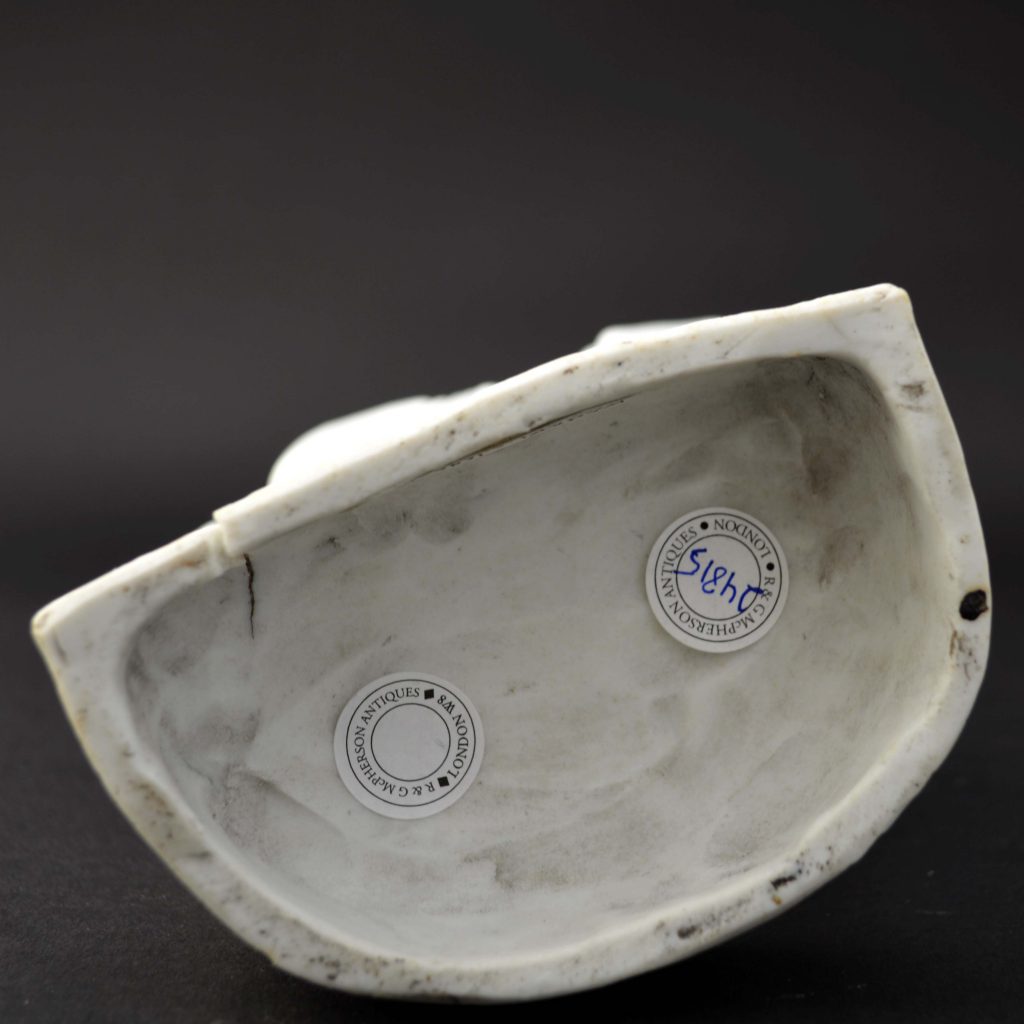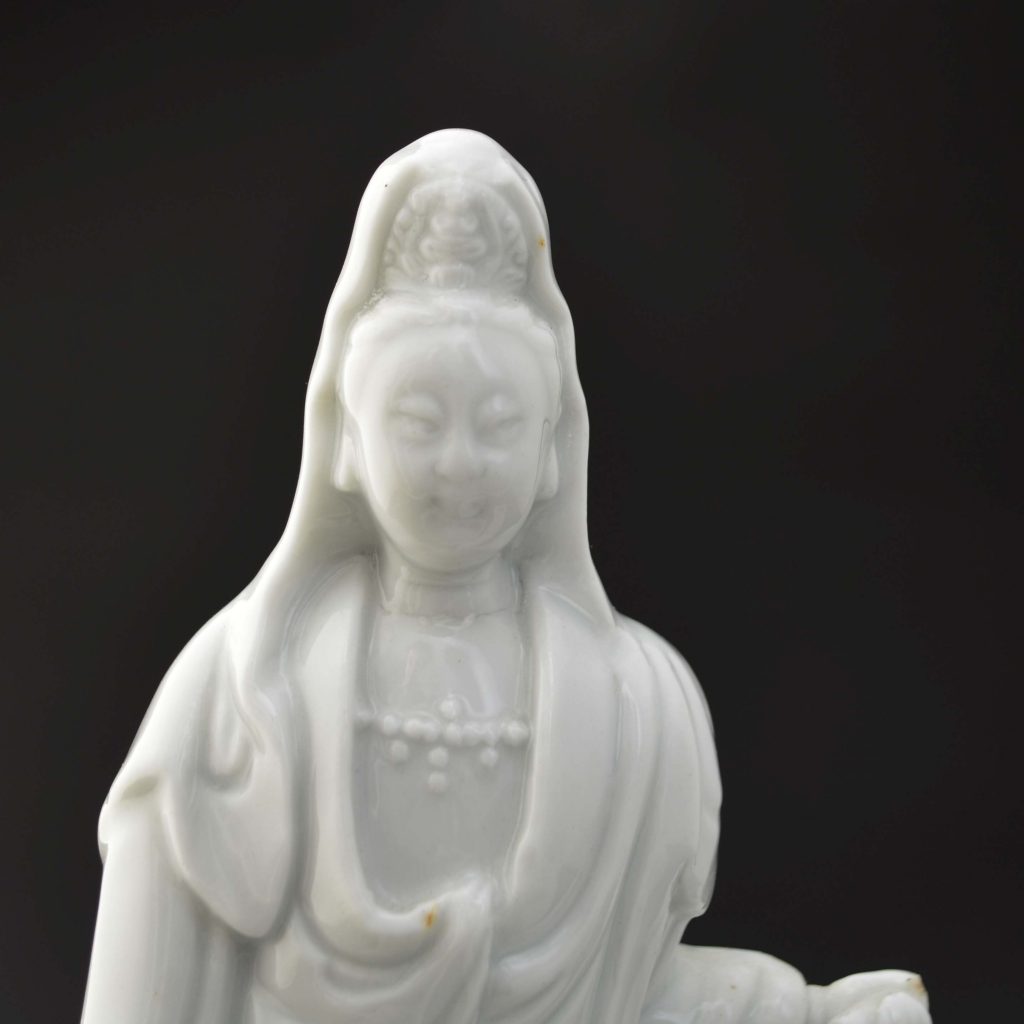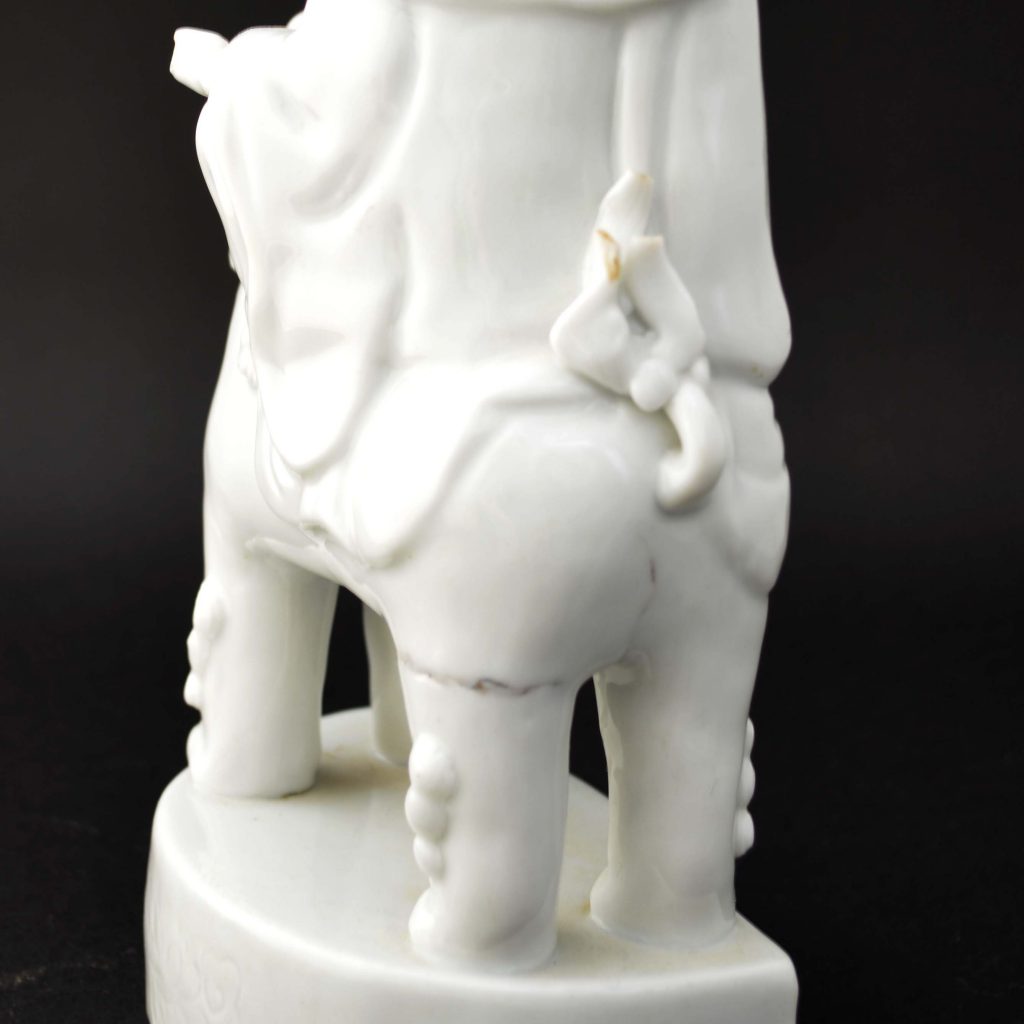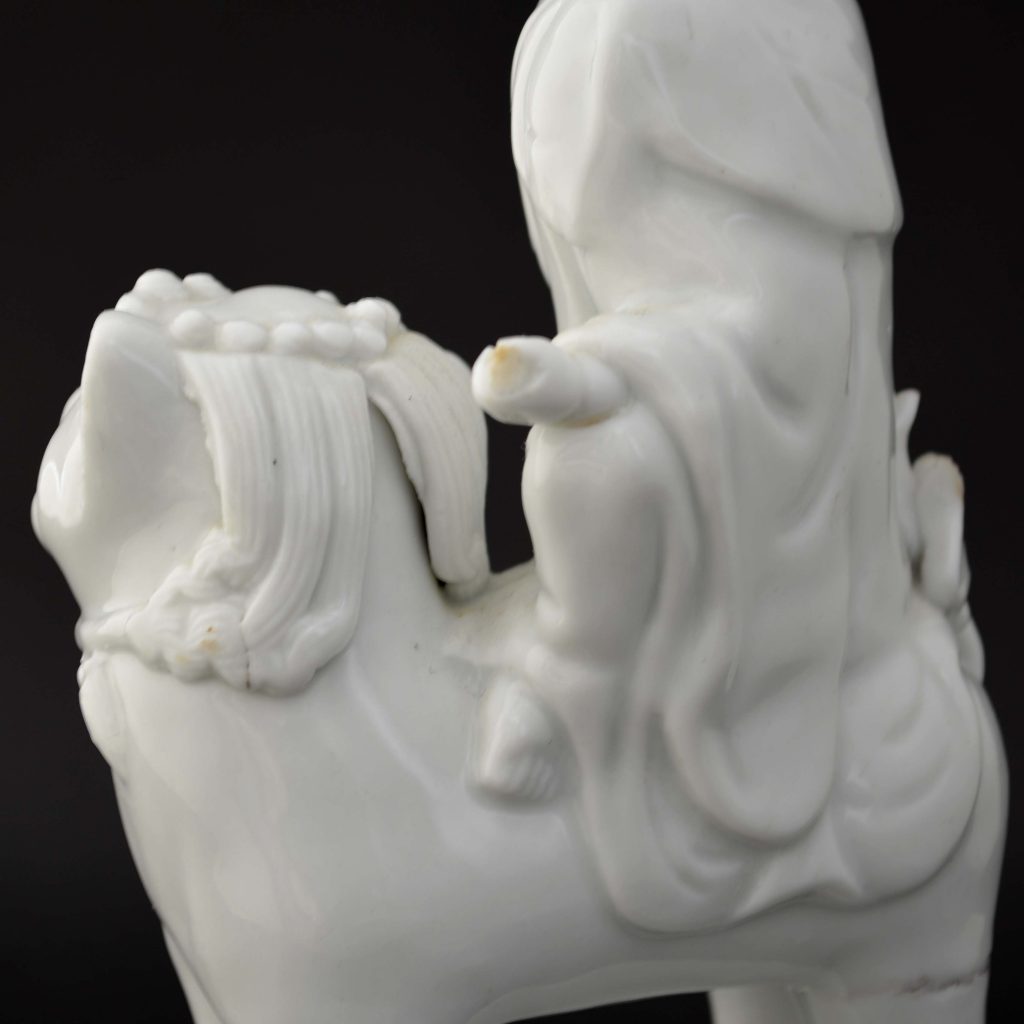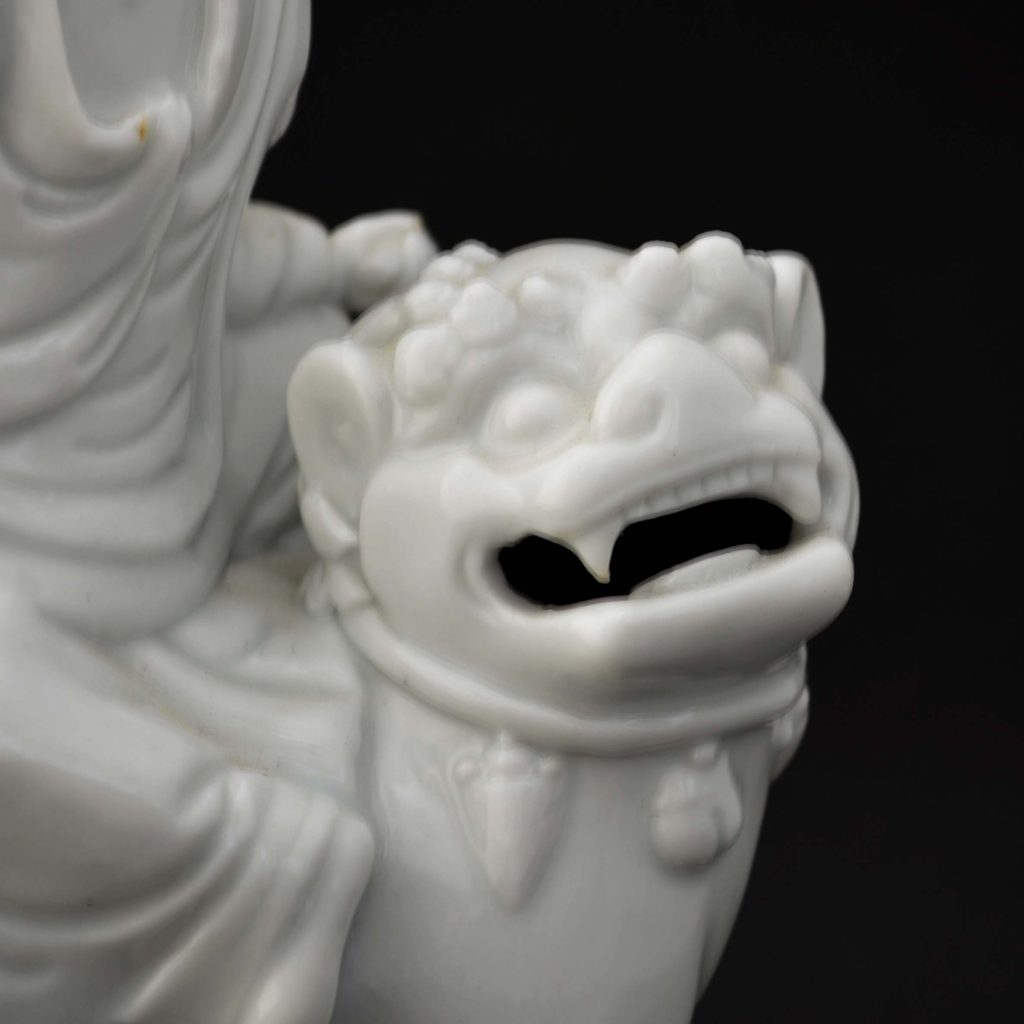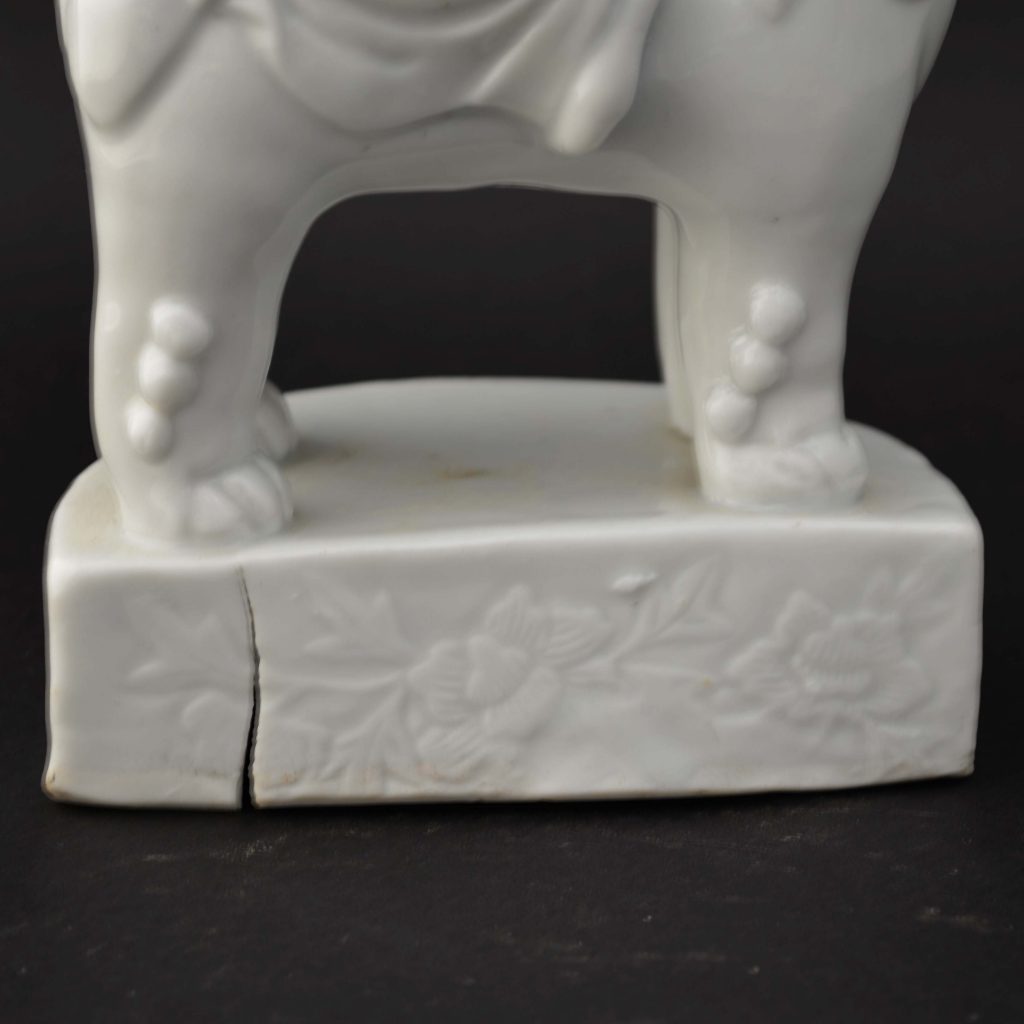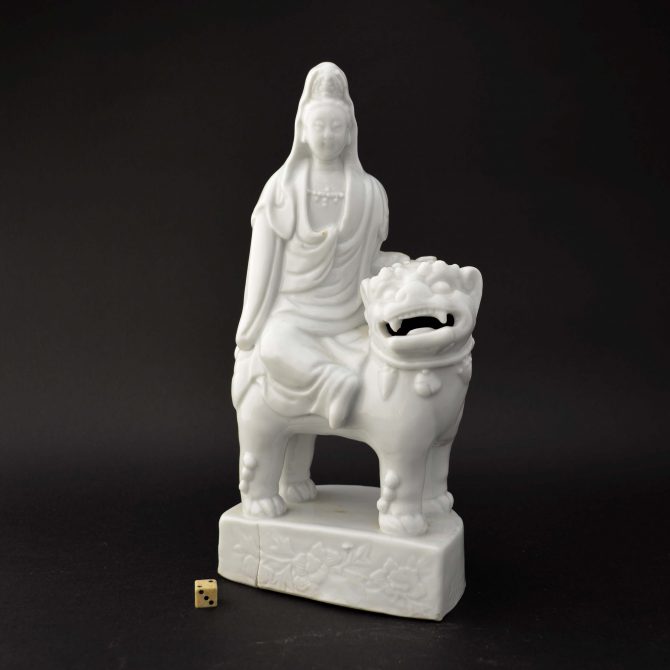
Kangxi Blanc de Chine Porcelain Model of Guanyin Seated on a Buddhist Lion.
A Kangxi period (1662-1722) Blanc de Chine porcelain model of Guanyin seated on a Buddhist lion, Fu Dog, from the kilns in Dehua, Fujian Province.
SOLD
- Condition
- In good condition, the end of the scroll Guanyin is hold is missing, the three tips of the Buddhist lion's tail are chipped. There is a large open firing crack to the front of the base.
- Size
- Hight : 22.5 cm (8 3/4 inches)
- Provenance
- From a Private European Collection of Antique Chinese Porcelain.
- Stock number
- 24815
- References
- For a very similar Blanc de Chine porcelain model dated to c.1680 see : Blanc de Chine (Forward by Richard P. Marchant, Marchant, London, Exhibition Catalogue 30th October - 21st November 2014.) page 72, plate 43.
Information
Guanyin :
Figures of Guanyin are by far the most common of all Blanc de Chine figures and indeed one of the most common images in Chinese figurative art. Guanyin was the Goddess of mercy, She was especially revered in the area where this figure was produced ; Dehua in Fujian Province. But her origins stem from Tibetan Buddhism, she was originally the patron saint of Tibetan Buddhism `Avalokitesvara`. Guanyin is actually the shorter form of the name Guan shi yin, which means “one who observes the voices of the world.” True to her name, Guanyin listens to and understands the worries that plague man`s existence. Because of her mercy and generosity, Guanyin is the most-loved of China`s divinities. the one people turn to for assistance in their everyday lives. Guanyin is specially venerated by those who are hoping to have children or those who are about to set out for sea. Guanyin is usually portrayed wearing a white cape. In her right hand, she holds a dish that has holy water. On her head is a crown in the style of the Amitabha-buddha. She is shown meditating in a seated position. Guanyin has been given the same qualities as the Virgin Mary of Catholic theology, which is why she is sometimes portrayed holding a child in her arms. While the worship of Guanyin in could be traced historically from India, she is the star of countless legends and folk tales in China. Guanyin`s home on earth was the Putuo mountains, located on an island on China`s eastern coast to the south of Shanghai. In China, Putuo-shan is one of the most sacred places in Buddhism and the temple dedicated to Guanyin on the mountain is one of the most important pilgrimage site for Buddhists and non-Buddhists alike. Guanyin`s birth is celebrated on the 19th day of February, and her enlightenment is celebrated on the 19th of September. On those days, the pilgrims flock to Putuo mountain.
Blanc de Chine Porcelain :
The porcelain known in the West as Blanc de Chine was produced 300 miles south of the main Chinese kiln complex of Jingdezhen. The term refers to the fine grain white porcelain made at the kilns situated near Dehua in the coastal province of Fujian, these kilns also produced other types of porcelain. A rather freely painted blue and white ware, porcelain with brightly coloured `Swatow` type enamels as well as pieces with a brown iron-rich glaze. However it is the white blanc de Chine wares that have made these kilns famous. The quality and colour achieved by the Dehua potters was partly due to the local porcelain stone, it was unusually pure and was used without kaolin being added. This, combined with a low iron content and other chemical factors within the body as well as the glaze, enabled the potters to produce superb ivory-white porcelain.
Blanc de Chine Figures of Guanyin :
Figures of Guanyin are by far the most common of all Blanc de Chine figures and indeed one of the most common images in Chinese figurative art. Guanyin was the Goddess of mercy, She was especially revered in the area where this figure was produced ; Dehua in Fujian Province. But her origins stem from Tibetan Buddhism, she was originally the patron saint of Tibetan Buddhism `Avalokitesvara`. Blanc de chine figures like the present example were constructed of separate pieces put together, this was a standard technique at the Blanc de Chine kilns in Dehua, it explains the huge variation of seemingly similar objects produced at the kilns. Figures from the Ming dynasty show a far greater degree of hand-modelling, with folds of material, the face, as well as fingers cut by hand. The potting tends to be thicker too, the interior space often shows cutting marks where the excess leather-hard clay was removed. The models of Guanyin from the Kangxi period (1662-1722) appear much more obviously mould-made, the modelling is normally more shallow with less definition and less hand-tooling. The interior wall often shows numerous small finger marks where the potter has pushed the clay into the mould. These figures, especially the taller ones frequently have ridges of porcelain supporting the interior moulded walls, they are pinched to form a ridge which is triangular in cross-section. Blanc de Chine Guanyin Figures : Figures of Guanyin are by far the most common of all Blanc de Chine figures and indeed one of the most common images in Chinese figurative art. Guanyin was the Goddess of mercy, She was especially revered in the area where this figure was produced ; Dehua in Fujian Province. But her origins stem from Tibetan Buddhism, she was originally the patron saint of Tibetan Buddhism `Avalokitesvara`. Blanc de chine figures like the present example were constructed of separate pieces put together, this was a standard technique at the Blanc de Chine kilns in Dehua, it explains the huge variation of seemingly similar objects produced at the kilns. Figures from the Ming dynasty show a far greater degree of hand-modelling, with folds of material, the face, as well as fingers cut by hand. The potting tends to be thicker too, the interior space often shows cutting marks where the excess leather-hard clay was removed. The models of Guanyin from the Kangxi period (1662-1722) appear much more obviously mould-made, the modelling is normally more shallow with less definition and less hand-tooling. The interior wall often shows numerous small finger marks where the potter has pushed the clay into the mould. These figures, especially the taller ones frequently have ridges of porcelain supporting the interior moulded walls, they are pinched to form a ridge which is triangular in cross-section.
Blanc de Chine Fu Dog or Buddhist Lion :
Blanc de Chine Fu Dogs are difficult to date, they were made in the provincial kilns of Dehua in Fujian province. There are very many versions, all of which are rather similar but really following the same basic model. Technically the production didn`t change much either, on the whole the earlier models have more hand-working. However, the present example has more hand working than the early Blanc de Chine Fu dog from the Hatcher Cargo, datable to circa 1643 ( see `Sold Items` stock number 19961 ). The potting, glaze colour and general finish all point to a specific period but accurate dating is, I believe, very difficult. Fu Dog, Buddhist Lion, Fo Dog :
When Buddhist priests, or possibly traders, brought stories to China about stone dogs guarding the entry to Indian Buddhist temples, Chinese sculptors modelled statues after native dogs for use outside their temples. The mythic version of the animal, was known as the Dog of Fo, the word Fo being Chinese for Buddha. The Buddhist version of the dog was originally introduced to Han China as the protector of dharma and these dogs have been found in religious art as early as c.200 BC. Gradually they were incorporated as guardians of the Chinese Imperial dharm. However, Chinese sensitivity metamorphosed the dog into a lion, even though lions were not indigenous to China, since this seems more appropriate to the dignity of an emperor when he used the beasts to guard his gates. The mythic dog is sometimes associated with feng shui, and are often called Fu Dogs. Fu means `happiness` in Chinese; however, the term `Fu Dog` and its variant Foo Dog, are not used in Chinese. Instead, they are known as Rui Shi (`auspicious lions`) or simply Shi (lions). There are various styles of imperial guardian lions reflecting influences from different time periods, imperial dynasties, and regions of China. These styles vary in their artistic detail and adornment as well as in the depiction of the lions from fierce to serene.
